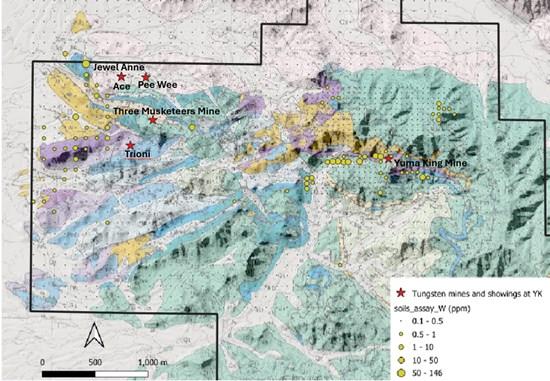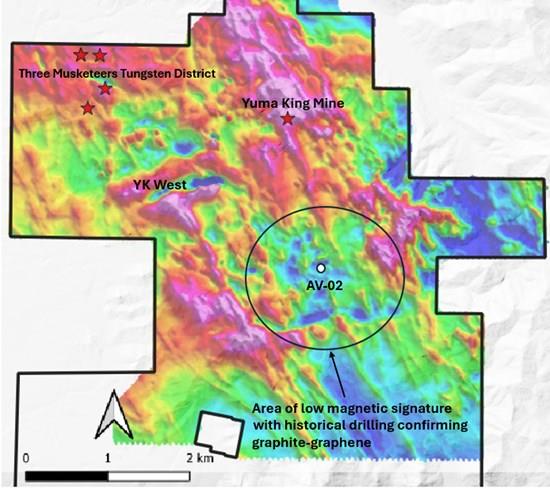
Corcel Exploration Announces Historical Critical Mineral Potential At Yuma King Project
| Sample ID | Au (ppb) | W (%) | WO 3 | Mine | Type | Length (inches) | Ore |
| R003 | 1260 | 0.217 | 0.27 | 3M | Channel | 18 | UG Ore |
| R004 | <10 | 0.774 | 0.98 | 3M | Channel | 24 | UG Ore |
| R009 | <5 | 0.235 | 0.30 | 3M | Channel | 12 | UG Ore |
| R014 | <20 | 1.85 | 2.33 | 3M | Channel | 60 | Outcrop of Ore |
| R015 | 26 | 0.153 | 0.19 | 3M | Channel | 48 | Outcrop of Ore |
| R039 | <30 | 4.94 | 6.22 | 3M | Channel | 12 | UG Ore |
| R040 | <20 | 2.88 | 3.63 | 3M | Channel | 3 | UG Ore |
| R041 | <120 | 15.2 | 19.15 | 3M | Channel | 8 | UG Ore |
| R020 | 48 | 0.439 | 0.55 | JA | Channel | | UG Ore |
| R021 | 18 | 0.254 | 0.32 | JA | Channel | 32 | UG Ore |
| R023-HG | <10 | 0.918 | 1.16 | JA | Channel | 3 | UG Ore |
| R024 | 32 | 0.145 | 0.18 | JA | Channel | 36 | UG Ore |
| R025 | <10 | 0.6 | 0.76 | JA | Channel | 2 | HG Ore |
| R026 | <80 | 9.66 | 12.17 | JA | Channel | 2 | HG Ore |
| R027 | <80 | 9.12 | 11.49 | JA | Channel | 2 | HG Ore |
| R028 | <30 | 2.67 | 3.36 | JA | Channel | 2 | HG Ore |
| R029 | <30 | 3.88 | 4.89 | PW | Channel | 2 | HG Ore |
| R036 | <3 | 0.24 | 0.31 | PW | Channel | 1 | HG Ore |
| R037 | <70 | 7.57 | 9.54 | PW | Channel | 2 | HG Ore |
| R032 | 45 | 0.16 | 0.20 | | Channel | | HG Ore |
| R033 | <15 | 0.98 | 1.24 | | Channel | | HG Ore |
| R038 | <25 | 3.04 | 3.83 | | Channel | 3 | |
| R043 | <5 | 0.47 | 0.59 | Ace | | 18 | Copper Prospect |

Figure 1: Location of the mines and prospects in the Three Musketeers Tungsten District with W in soils.
To view an enhanced version of this graphic, please visit:
Graphite and Graphene Mineralization
Graphite and graphene mineralization at the Yellowbird deposit on the Yuma King Project was first identified in 2011 by a drill campaign by VANE while exploring a porphyry copper target (See 43-101). The graphite is contained in a relatively flat-lying, dark gray, carbonaceous, phyllitic meta-mudstone body about 150 m thick, intercepted in drill hole AV-2. A 25-metre interval within the middle of the 150-metre section consists of approximately 89% carbonaceous mudstone. Follow-up geochemical sampling and Raman spectrometry in 2015 confirmed graphite with significant graphene (see 43-101 Report dated December 1, 2024, available on Corcel's website).
In 2016, Cash Capital completed a four-hole, 1,220-metre drill program accompanied by geologic core logging, continued lab geochemical assays, mineralogic studies, and reconnaissance field sampling, which demonstrated that the mineralized horizon extends southward and identified additional graphite-bearing zones within the Yellowbird black shale formation. Corcel is working to obtain technical data from this program - at present, the precise drill hole locations and other data are not available (see 43-101 Report dated December 1, 2024, available on Corcel's website).
The graphite mineralization is interpreted to be related to thrust-related deformation and metamorphism during the early Laramide orogeny.

Figure 2: Area of the Yellowbird graphite-graphene deposit, showing discovery drill hole AV-02 and low magnetic signature from drone magnetic survey total magnetic intensity (reduced to pole).
To view an enhanced version of this graphic, please visit:
US Critical Minerals
The United States is currently entirely reliant on imports for both tungsten and graphite, which are classified as critical minerals by the U.S. Department of the Interior (U.S. Geological Survey, USGS, 2024 Critical Minerals List) and recognized as essential to national defense by the U.S. Department of War (U.S. Army, Defense Logistics Agency Strategic Materials). Tungsten is used in electronics, aerospace components, defense systems, while graphite is the primary material in lithium-ion battery anodes and plays a central role in electrification and energy storage technologies.
Evaluation of Critical Minerals at Yuma King
The Company will incorporate the historical tungsten and graphite datasets into the broader geological model for the Yuma King Project. This work is being undertaken in parallel with the copper-gold exploration strategy to assess whether these critical mineral systems warrant follow-up evaluation as potential complementary targets.
Qualified Person as defined under National Instrument 43-101
Roy Greig, Ph.D., P.Geo, a Qualified Person ("QP") as defined in National Instrument 43-101 Standards of Disclosure for Mineral Projects, and advisor to Corcel Exploration Inc. has reviewed and approved the technical content in this news release. The QP has not been able to verify the historical exploration data disclosed herein since the original materials and documentation are presently inaccessible. Nonetheless, this data is believed to be accurate and sufficient for purposes of guiding future exploration on the Yuma King project.
About Corcel Exploration Inc.
Corcel Exploration is a mineral resource company engaged in the acquisition and exploration of precious and base metals properties throughout North America. The Company has entered a long-term lease agreement to acquire the Yuma King Cu-Au project in Arizona, which spans a district-scale land position of 3,200 hectares comprising 515 unpatented federal mining claims in the Ellsworth Mining District, including the past-producing Yuma King Mine which saw underground production of copper, lead, gold and silver between 1940 and 1963. The Company also holds a 100% interest in the Willow copper project. For more information, please visit our website at .

Legal Disclaimer:
MENAFN provides the
information “as is” without warranty of any kind. We do not accept
any responsibility or liability for the accuracy, content, images,
videos, licenses, completeness, legality, or reliability of the information
contained in this article. If you have any complaints or copyright
issues related to this article, kindly contact the provider above.
















Comments
No comment